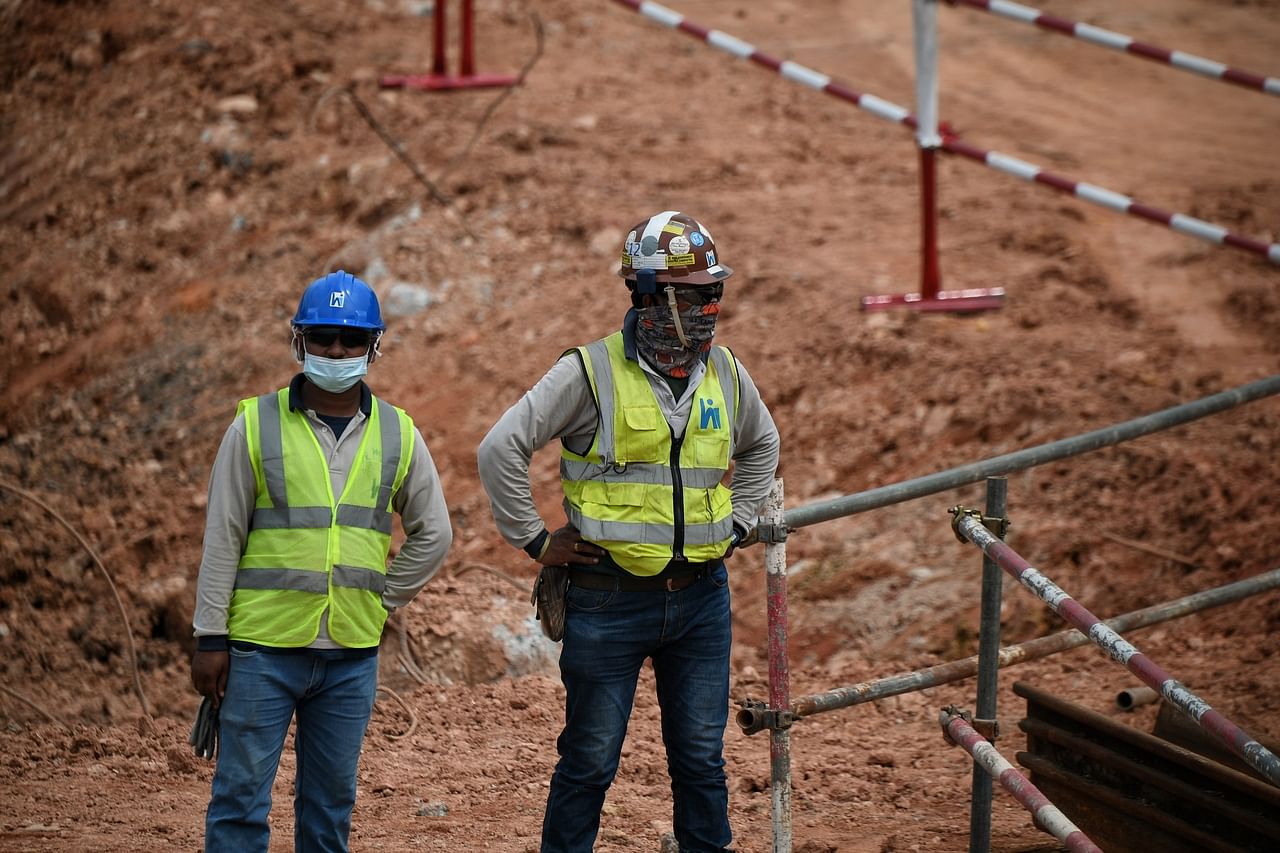SINGAPORE - Electricians have any number of high-tech tools at their disposal these days such as laser measurement devices but the whizzy gadgets still cannot replace skilled tradesmen.
No matter how advanced equipment gets, most still require a trained operator and many of these roles are filled by migrant workers.
Mr John Tan, managing director of TYE Engineering, an electrical works contractor, said his company has adopted new technologies in its daily work where possible, but it is impossible to scale back on manpower.
"It's very hard to go fully automated because each job site has different requirements and some things can only be done manually by skilled workers," said Mr Tan, who employs around 12 foreign workers as electricians and another eight as assistants.
The new entry restrictions imposed on South Asian workers have effectively dried up the pool of workers in the construction industry, which has been grappling with an already diminished workforce since the onset of the Covid-19 pandemic last year.
Workers from India and Bangladesh make up the majority of construction workers here.
Some industry players estimate that the pandemic has brought technology adoption forward by around five years but applying these advances to relieve manpower shortages is not as straightforward.
Take prefabrication technology that allows structures to be made in a manufacturing facility before being assembled on site.
This may work for Housing Board (HDB) flats or condominium projects but it may not apply to building landed properties.
THL Construction director Ian Teo said: "For HDB blocks or condos, every level is copy and paste, so using prefab can help cut down the lead time. But each landed property looks different so it's difficult to implement.
"Small builders like us will try out automated machinery if it makes economical sense for us to do so. However, most of the current machinery are catered mainly for larger scale projects."
The disruptions caused by Covid-19 have prompted the Government to urge the construction industry to adopt digital solutions.
One such solution is tapping cloud-based platforms to collaborate digitally on construction projects to reduce the reliance on paper-based processes.
Multiple roles
Contractors told The Straits Times that they are finding it hard to replace skilled workers, such as electricians and air-conditioning technicians, who have spent years refining their workmanship.
Small firms like Mr Teo's typically keep a lean team and cross-train their workers to do multiple roles, as they take on only three to five sites in a year.
A bricklayer, for example, may also be trained to lay tiles.
"We can try to get more workers from other source countries but people forget we need time to train workers," said Mr Teo, adding that it takes between two to three years to get unskilled workers to semi-skilled and even longer to be proficient at their jobs.
Workers also have to adhere to safe management measures at sites, which has greatly hindered productivity.
These measures require contractors to split sites into zones and workers have to stay within their designated areas to prevent intermingling.
In practice, this means that jobs that would typically run concurrently, such as ceiling and electrical work, to save time are now split up, resulting in less efficient workflow and longer delays, say contractors.
"Working in zones means that team B can only come in when team A leaves, and the cycle repeats," said Mr Teo. "What could have been done in two weeks last time will probably take three to four weeks now."
And the challenges for contractors do not end there. The number of workers allowed on a site at one time has also been drastically reduced.
Before Covid-19, there could be 60 to 70 workers on site at the peak of a big project such as a shopping mall, said Mr Leong Cheng Wee, director of Method Engineering.
These days, there are barely enough workers to go around, even if safe management measures do not already limit the numbers on site, he added.
"In the past, if you have four or five ongoing projects, you can call on additional help from your sub-contractors and they will send people. But now, it's not possible because everyone is short of workers," said Mr Leong.
"Now you've got to ration your workers - maybe you send two or three workers instead of 10 workers to appease your clients," he added.

Contractors like Mr Leong say they are now hesitant to bid for new jobs and are adopting a wait-and-see approach.
"If there are not enough workers to handle the projects and they drag on, you risk spoiling your relationship with your clients and, even worse, overhead costs keep piling up and your company is at risk of closing down," he said.
Specialists Trade Alliance of Singapore executive director Eddy Lau said it is not uncommon for bosses to roll up their sleeves to supervise workers at sites given the struggle with manpower shortage.
"It has reached a stage where it's quite difficult to do planning," he noted.
"But we're thankful that Covid-19 cases in the dorms have been quite stable these days so at least work can still continue, even though it may take longer to complete."
Impact on key healthcare, housing and infrastructure projects
Delayed
Woodlands Health Campus
The first hospital in Woodlands, which will have 1,800 beds, was originally scheduled to progressively open from next year. It will now open from 2023.
Tan Tock Seng Hospital Integrated Care Hub
The 500-bed rehabilitation complex that will be connected to the main hospital building via a sky bridge will open in 2023, a year later than planned.
Singapore General Hospital Emergency Medicine Building
The accident and emergency facility, which will be connected to the main hospital complex and the nearby Outram Community Hospital, will open in 2024, a year later than planned.

Polyclinics in Eunos, Kallang and Bukit Panjang
The polyclinics were originally scheduled to open at the end of last year, but are now expected to open by the end of this year.
Build-to-order (BTO) housing projects
Some BTO projects are expected to be pushed back by a year or more, up from the original delay timeline of six to nine months, although it is unclear what projects will be affected. There are 89 BTO projects under way.
Thomson-East Coast Line
Stage two of the MRT line, which was slated to open by the first quarter of this year, is now expected to open in the third quarter. The rest of the line will open progressively in three stages from 2022 to 2025.
Jurong Region Line
Construction of most of the stations and viaducts on the seventh MRT line is under way. It is scheduled to be completed by 2029, one year later than originally announced.

Cross Island Line
Construction for stage one of the eighth MRT line has started. Stage one is scheduled to open in 2030 and the Punggol extension is due to open in 2032, both a year later than originally announced.
North-South Corridor
The 21.5km expressway to link the northern parts of Singapore to the city centre is expected to be completed in 2027, a year later than originally announced.
Cycling path network
The completion of cycling paths may be delayed by a year due to shortages of construction material and workers, but the Government said it is still committed to tripling paths across Singapore to around 1,300km by 2030.
Johor Baru-Singapore Rapid Transit System Link
The targeted passenger service commencement date has been deferred from the end of 2024 to the end of 2026. The 4km cross-border train connects Woodlands in Singapore to Bukit Chagar in Johor.

Changi Airport Terminal 5
Construction of the mega terminal has been paused for at least two years to allow for a review on prospects for the aviation sector, which has been battered by the pandemic. It was initially scheduled to be completed in the 2030s.
On track
Tuas Port
Phase one of land reclamation work for Tuas Port is on track to be completed by the end of this year.
Deep Tunnel Sewerage System
Work on the $10 billion used water "superhighway" is on track for completion by 2025. About a quarter of a 100km-long conveyance system has been completed.


